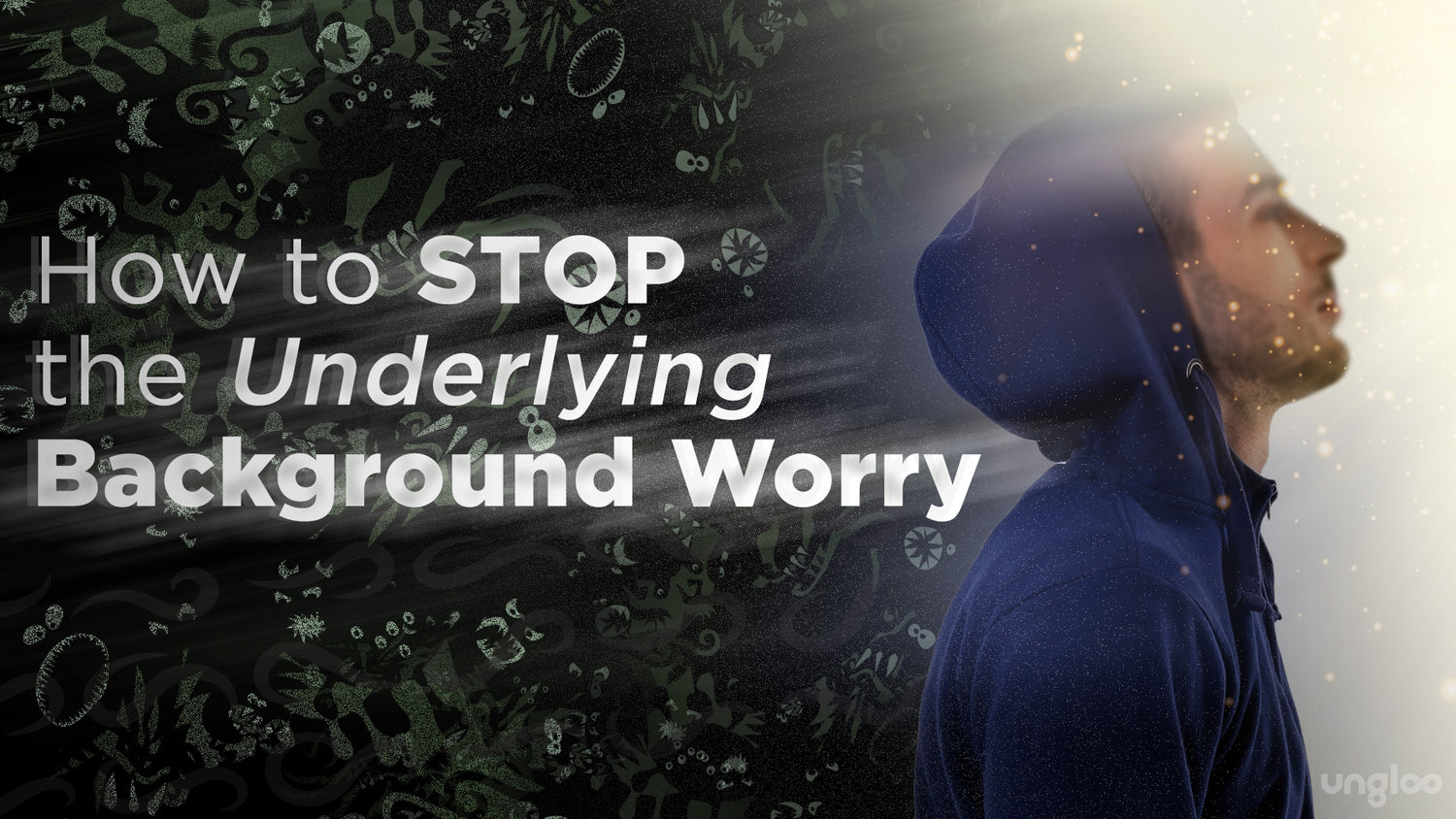Can't get rid of that negative voice in your head? This is called background worry, and it can be quite intrusive for many people.
I've always felt relief knowing that worry is a normal human condition that happened through evolution. Those who worried the most were the ones with the fattest stockpiles or took extra time to waterproof their shelters or took appropriate action to protect their children. And so if you worry then, congratulations, you're human. You evolved for 1000s of years as offspring of some best worriers on Earth! All of your ancestors were EXCELLENT worries, because if they weren't worrying they would have died and not had children.
The funny thing is, now that most of us have our basic needs met we no longer need to put so much energy into worrying. And now that humans are living twice or three times longer, those that worry well into their older years end up creating a mountain of unnecessary stress on their bodies. What's really cool is now our brains have evolved enough for us to know when worry is taking over and we can now become self aware enough to channel that worry energy into mindful productivity. And that's like turning your kryptonite into your superpower.
When it comes to improving mental health, we're always looking for solutions. But unfortunately, for some, background worry or anxiety can be a constant thorn in their side. This background noise can be highly distracting and lead to anxiety and depression.
Luckily, there are ways to slow down that voice and improve your mental health. This blog post will discuss meditative strategies and techniques for becoming more aware of background worry, and mindfulness tips to help you clear your head and have more control over your experiences.
Keep reading for the complete guide!
What Is Background Worry?
Background worry is a negative, mental noise that can subconsciously ruin positivity and lead to anxiety and other health issues.
There are many causes of this, but one of the most common is worrying about things we can't control. This can include worrying about the future, the past, or what other people think of us.
When we worry, our bodies go into fight-or-flight mode and release stress hormones like cortisol. This can lead to many physical symptoms such as headaches, muscle tension, and difficulty sleeping.
Over time, chronic stress can lead to serious health problems such as heart disease, high blood pressure, and depression. Luckily, there are ways to slowdown the underlying background worry. One of the most effective ways is to practice meditation and mindfulness.
Benefits of Meditation for Silencing Background Worry
Meditation can help us to focus our attention away from negative thoughts and become more aware of the present moment. When we meditate, we train our minds to become calmer and more peaceful.
Meditation is shown to be an effective treatment for anxiety and stress. A study published in the journal Frontiers in Psychology found that meditation can help to reduce the harmful effects of worry. The study found that people who meditated boosted mindfulness and emotional regulation.
How to Stop Underlying Background Noise (Worry, Anxiety)
There are many different types of meditation to help with worrying, so let's go through the best methods for silencing background worry.
Mindfulness Meditation
Mindfulness meditation is a form of meditation where you focus on the present moment. You observe your thoughts and emotions without judgment. This can help you to become more conscious of your thoughts and feelings and learn to let them go.
During mindfulness meditation, breathe deeply. Then, focus on your thoughts and emotions without judgment. This practice also helps you become more grounded and less focused on your worries.
Breath Focus Meditation
Breath focus meditation is a simple yet powerful method to reduce worrying. In this type of meditation, you focus on your breath. This helps to bring your attention to the present moment and away from your worries.
You breathe deeply, slowly, and fully (abdominal or belly breathing). As you breathe, your mind gradually detaches itself from unhelpful sentiments and feelings. This practice can help to calm the mind and reduce anxiety.
Body Scan Meditation
Body scan meditation mixes breathwork with progressive muscle relaxation.
During body scan meditation, you perform a few minutes of deep breathwork to relax your body. Then you focus your attention on your body from head to toe. First, notice any sensations you feel in your body, such as tension or pain. Then you want to mentally release the physical tension you feel there.
A mind-body scan may help you become more aware of the mind-body connection. This enables you to focus on the present moment and let go of any background worry that you feel in your body.
Guided Imagery
Guided imagery is a type of meditation where you are directed by a teacher, audio recording, or app. You focus on your breath and pay attention to the guidance, which can be about relaxation, stress relief, or self-compassion.
You can think of calming places or images to focus on. There are free apps to help you practice guided imagery and other meditations for worry. If you use an app, choose imagery you find calming and relaxing.
Guided imagery may help you reinforce positive thoughts and reduce stress. It can also help to improve sleep quality and reduce pain levels.
Movement Meditation
Movement meditation is a type of mindfulness meditation that uses movement to focus your attention on the present moment. In this type of meditation, you can use practices such as walking, yoga, Tai Chi, or Qigong.
The key is focusing your attention on your body and the sensations you feel as you move. For example, you can focus on the sensation of your feet touching the ground as you walk. Or you may focus on your breath and the movement of your body as you perform yoga stretches.
Movement meditation can help to improve physical and mental health. It can also help to reduce stress, anxiety, and depression.
Mindfulness Tips for Reducing Background Worry
Now that you know the different types of meditation to reduce background worry let's go over some mindfulness tips to help reduce worry.
Start with a Short Practice
When you're new to meditation, it's good to start with a short practice, so you don't get overwhelmed. You can start with a practice of five minutes a day and increase the length of your routine as you become more experienced.
For an easy starter routine, find a comfortable place to sit or lie down. Then focus on your breath and pay attention to your thoughts and emotions without judgment. If your mind wanders to stressful thoughts, gently bring your attention back to your breath.
When you're finished, take a few deep breaths and notice how you feel.
Find a Favorite Spot Outdoors that Brings You Joy
Finding an outdoor place that brings you joy and peace can help clear your mind. It may be where you feel safe and relaxed, such as in your backyard, a local park, or a hidden spot in the forest.
When you're feeling stressed or anxious and can't meditate, take a few minutes to visualize yourself in this happy place. Notice the sights, sounds, and smells around you. Feel the peaceful and calm energy of this place surrounding you.
Take some deep breaths and let go of any current worry or stress you're feeling. You can stay in this peaceful place for as long as you need.
Create a Calming Routine
It can be helpful to create a calming routine that you can do before or after your meditation practice. This can be as simple as brewing some tea, reading a book, or writing in your journal. Choose activities that make you feel good.
Creating a personalized routine may help reduce stress and anxiety levels and improve your overall mood. You'd be surprised what a difference a simple daily routine can make in your life and the changes it can bring.
Observe Your Thoughts and Emotions
Sometimes our thoughts are just us overthinking a situation, but sometimes there are serious issues that cause us to worry. It can be helpful to observe our thoughts and emotions to see what might be causing stress or anxiety.
Try to observe your thoughts and emotions without judgment. Simply notice them and then let them go. Don't try to hold on to positive or happy thoughts, either. Just let them come and go as they please.
Contact a Hypnotherapist
Subconscious thoughts and emotions can have a significant impact on our mental health. And sometimes, it's hard to access these thoughts on our own. If you're struggling to reduce background worry or anxiety, consider hypnotherapy.
A hypnotherapist can help you identify the root cause of your anxiety and work towards resolving it. This can be an effective way to improve your mental health and work through unidentifiable issues.
Let Go of Perfectionism
Common causes of anxiety include perfectionism. We often put unrealistic expectations on ourselves and then worry when we don't meet them. It's important to remember that we're human and that we all make mistakes.
Try to let go of the need to be perfect---it's impossible! Instead, accept yourself for who you are and know that you're doing the best you can.
Acknowledge Your Worry
When you're feeling anxious or stressed, it's helpful to acknowledge your worry. You can say something like, "I'm feeling worried about my upcoming work presentation." or "I'm feeling anxious about my fight with my partner."
Acknowledge your worry, and then let it go. Don't dwell on it or try to fix it. Sometimes acknowledging fear is the best way to relieve yourself of it.
Release Your Worry to the Universe
Releasing your worries to the universe means letting go of any attachment to the outcome and trusting that everything will work out. We all have a destiny and a path that we're meant to follow---everything happens for a reason!
Release your worry to the universe and trust that everything will work out for the best. Let go of any attachment to the outcome.
Enhance Your Meditations with the Ungloo
Meditation is an effective way of silencing background worry. It helps us to become more aware of the present moment and reduce stress and anxiety.
If you're new to meditation, starting with a guided meditation is best. Then, once you've practiced for a while, you can try other types of meditation.
Shop the Ungloo Box today and discover how it can help you reduce the underlying background worries in your life!



